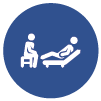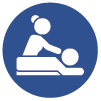Suffering from pain can be isolating and frustrating especially if you are bedbound because of it. It is not just a physical sensation but is also accompanied by an emotional response and an act of reasoning. Pain is a personal experience that can be hard to communicate. It is, therefore, necessary that your medical provider effectively analyzes you and suggest the right treatment for your pain.
Pain is of two kinds; acute and chronic. Acute pain is typically short-lived and is a result of an injury, trauma or surgery. Chronic pain, on the other hand, can be persistent and last longer than the normal healing time (more than 3 months). Chronic pain can hinder the performance of the most basic of tasks and require immediate medical attention.
What is Pain Management?
Acute pain normally heals within three months with the help of minimum medications. Chronic pain, however, requires you to seek medical help to manage pain. Pain is not something in your head and the intensity can vary greatly- from mild, sharp to dull and severe. It occurs due to a series of physiological (related to body functioning) events in the body. The person suffering from pain can be most useful in providing important information for evaluating pain as he is the one experiencing it. Each person has a different way of reacting to pain. Muscle pain is often described as dull or throbbing ache whereas nerve pain is referred to as burning, shooting or stabbing. Pain rating scales can be used by medical providers to determine or measure pain.
Pain experienced can be mild or severe, acute (sudden) or chronic (persistent). Acute pain may be accompanied by physiological signs such as rapid heart rate, sweating, increased breathing and grimacing. Chronic pain may not show any physiological signs and can be more difficult to treat as compared to acute pain. Persistent pain can disturb your daily life by making it harder to perform tasks. In most cases, a pain management team is prescribed to provide or select an effective pain management plan.
- Alternative health care providers (e.g. doctors and others)
- Chiropractors
- Nurses and nurse practitioners
- Occupational therapists
- Physicians (such as physiatrist, psychiatrist, pediatrician, oncologist, and others)
- Pharmacists
- Physical therapists
- Social workers and psychologists
Here, it is important to note that a person suffering from pain trusts and communicates with his/her patient management team. In instances where there is a lack of trust or communication can result in ineffective pain treatment. The process of pain management plan starts off by an initial pain evaluation. This involves asking questions regarding your personal and family medical history, performing a physical examination and completing pain assessment. Sometimes laboratory tests are also taken (e.g. blood tests) depending on the need of an individual.
Why is pain assessment important?
- Provides information and detailed analysis
- Understand the cause of the pain to help in determining the most suitable treatment option
- Defines the severity of pain
- Help determine other important factors such as factors that improve or worsen your pain, how pain is affecting your ability to perform tasks and others.
- Monitoring the pain to determine if the treatment is bringing any change or not.

The treatment is chosen mostly depends on the purpose and type of pain experienced. Acute pain is short-lived and is resolved as the body is healed- provided there was no nerve damage. Chronic pain exists even after the healing has taken place. Pain assessment also involves your medical provider asking you a series of questions. And so, it is important that you communicate properly. Lack of communication can result in an ineffective treatment plan. You can also ask questions from your healthcare provider to better understand the cause of your pain and the treatment plan.
Guide to Pain management plan

Just as each person has a different way to respond to pain, they also respond to pain treatments differently. Pain treatment plans, therefore, are tailored to fit into an individual’s requirement and need. The pain treatment plan differs from patient to patient. When developing a plan, healthcare providers may take into account many factors such as a person’s health, condition, and his or her personal preference. Such as some patients might be comfortable with medicines while others may prefer therapy. Regardless, an effective pain treatment plan requires equal participation from both parties; the patient and his medical provider or pain management team. The most basic goals of the pain treatment plan include
Decreasing or eliminating pain completely
Improving the quality of life of the person suffering from pain
Capitalize on the patient’s ability to function and perform routine tasks such as dressing etc.
A pain management plan is tailored to fit your individual needs and situation. This is why it will be different for every patient. It mostly involves you and your medical health provider or a pain management team as mentioned above. Your doctor is responsible to treat any condition that might be causing your pain. A pain management plan is focused on managing the pain itself. Many people suffering from chronic pain can experience difficulty in performing routine tasks. Chronic pain can also take longer to heal and sometimes remain even after the treatment. Devising an effective pain management plan can help reduce pain, help you function better and improve the quality of your life. A pain management plan aims to reduce pain sensations, help you move and sleep better and many others. When it comes to a pain management plan, you and your doctor will both work together to set goals and outcomes expected out of the treatment recommended. Your doctor will recommend treatments and self-care strategies to assist in achieving those goals. Therefore, a pain management plan consists of
Outlining pain management goals to be achieved after the treatment
Pain management strategies where you and your doctor explore treatments and self-care strategies
Monitoring the effect of treatments on controlling pain
The pain management plan starts off with establishing goals that you would want to achieve or expect to achieve during the course of the treatment. Chronic pain never completely goes away for many patients. The goals may include reducing pain, help in moving better or sleeping better, improving the quality of life or all of them. One good way to answer this better is by thinking of the activities you are not able to perform anymore or have stopped enjoying as a result of your pain. You can also use a pain rating scale to determine the level you are at currently and where you want to be after the treatment. The next step is to determine, with the help of your doctor, the most suitable pain management strategies for yourself. This involves answering a series of questions related to physical or occupational therapy treatment, specialty consultation, mental health, sleep, and medication. You may also want to mention your sensitivity towards developing an addiction and recommending medicines that have previously been helpful or you would want to avoid- if any. The last step includes determining a self-care treatment that will help you in managing your pain effectively. Below, we have mentioned the different pain management strategies and self-care tips.
Pain management strategies
The pain treatment plan includes the use of medication in the beginning. As more and more types of pain medications are coming into the market, people in the US have a wide range of new medication options to choose from to treat their pain. Opioids have become very common especially to treat chronic pain. Where opioid medication is extremely effective however, the risks associated with the use of this medication should also be taken into account. An opioid risk-assessment tool can be useful in figuring out whether the person should be given opioid treatment or not. Pain management plans often consist of other treatment methods as well. The following treatment methods and therapies are used to make pain management and its treatment effects.


Anesthetic pain management
This involves the use of anesthesia to treat pain. Previously, anesthesia was used to control pain that was caused during surgery. lately, anesthesia is used to treat various other kinds of pain as well.

Chiropractic treatment
This treatment is a less invasive method as it focuses on aligning your spine, soft tissues, nerves, and vessels to encourage healing.

Cryotherapy
It involves the use of freezing temperatures to control and manage pain. This method works best to treat inflammation. Ice can also be used to treat pain or reduce swelling caused after an injury.

Diathermy
This method involves the use of high-frequency electric current to heat deep tissue.

Neurostimulator procedure
This method is used to block pain signals to the brain. A device is used to release tiny electrical impulses to stimulate the nerves or spinal cord.

Neurosurgical pain management
Involved with nerve or spine surgery.

Behavioral methods of pain control
Methods such as hypnosis guided visual imagery, meditation and others have become extremely common and an effective way to control pain. These treatments basically alter the effect of pain on the patient, mainly targeting thoughts and behaviors. By making patients focus on changing their thoughts and the way they perceive pain, medical providers can help them control their pain.

Physical therapy
This is one of the most common methods to control and treat pain. It makes use of therapeutic exercise and massage, joint manipulation, heat/cold therapy, nutrition to reduce inflammation, alternative treatments, and others.

Psycho therapy
This method involves a psychologist that will help one deal with the stress that is aided by pain. It also helps patients cope with pain. Patients can learn to communicate better by explaining what they are feeling and being more open about their pain experience.
Self-care strategies
There are many self-care options available to treat your pain. This can be used or practiced along with the other treatment options mentioned above or individually as well.

Patient family education
Suffering from pain can be difficult not only for the person himself but also for their family. Hence, educating the patient and his family about the cause and type of pain experienced can help in treating the pain especially if your medical provider is not around.

Community support groups/educational plans
Patients who are going through the same pain experience can help each other by expressing and talking about their feelings and how they deal with their pain. This can be enriching for people especially the ones who feel lonely during this time period.

Exercise; yoga, walking, and others
Yoga and walking involve the mild movement of the body which can have a great impact on your overall health. They are a great and effective way to treat mild pain that can be fixed by allowing your body to move and stretch.

Heat or ice treatment
This treatment can be effective in treating pain that is caused by sore muscles or joint problems. All you have to do is take a warm cloth and press it against the affected area to treat your pain. Ice can be a great way to treat swelling and pain by simply pressing ice either directly or wrapped under a cloth, against the affected area.

Massage
Getting a massage regularly can in reducing stress and relaxing your body. It heals the body by breaking down tension and pressure on the nerves.

Relaxation through deep breathing
Deep breathing is another way to get your body in control and free it from any tension or stress.

Others
A great emphasis is put on the effect changing thoughts can have on pain management. Therefore, changing your thoughts or shifting your attention to something else can help you take your mind off of the pain. Reading, walking and talking to someone close can help you relax and provide a change of pace. Music improves mood and is a great way to release tension. Listening to music can help in managing pain. Quitting tobacco, managing weight, improving sleep habits and practicing meditation or relaxation can all be helpful in self-management of pain.
Self-reporting can be the most important factor in determining the correct pain assessment. When it comes to devising a pain management plan, both you and your doctor should act as a team to correctly figure out the right pain management strategies and treatment plan. Being expressive during the treatment plan is equally important and necessary.


